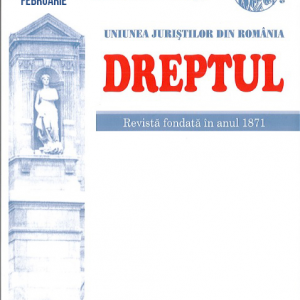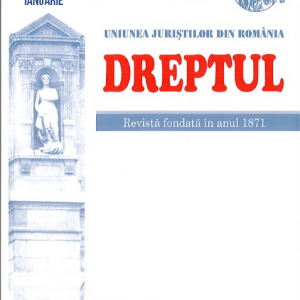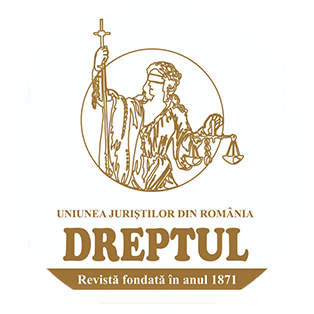-
 The study aims to demonstrate ability to expand criminal proceedings regardless of the current procedural stage, on grounds of its general trait of being indivisible, as well as its ways of expression during the prosecution phase within the procedural framework set forth in article 238 in the Criminal Procedure Code. There are also reviewed the legal nature of the ordinance extending the criminal investigation and its trial functions, as well as the legal effects of the expansion of criminal proceedings during the first stage of the Romanian criminal trial over other procedural institutions. From the perspective of the new criminal procedure code, the avatars of this extremely important procedural institution for the criminal prosecution phase are tracked and analyzed comparatively.
The study aims to demonstrate ability to expand criminal proceedings regardless of the current procedural stage, on grounds of its general trait of being indivisible, as well as its ways of expression during the prosecution phase within the procedural framework set forth in article 238 in the Criminal Procedure Code. There are also reviewed the legal nature of the ordinance extending the criminal investigation and its trial functions, as well as the legal effects of the expansion of criminal proceedings during the first stage of the Romanian criminal trial over other procedural institutions. From the perspective of the new criminal procedure code, the avatars of this extremely important procedural institution for the criminal prosecution phase are tracked and analyzed comparatively. -
 In the study hereby, the author reviews provisions of the new Romanian Civil Code (enacted by Parliament, published in the „Official Gazette of Romania”, Part I, in July 2009, but still unenforced) on the artificial property accession, by reference to the current Civil Code (since 1865), still in force, and to the relevant Romanian jurisprudence and doctrine. Conclusion of the analysis is that, on the one hand, the new Romanian Civil Code in the matter of artificial property accession keeps the rules and principles enshrined in the current Civil Code, doctrine and jurisprudence, though it reveals the innovating desire of the new Code, where the current Code keeps silent.
In the study hereby, the author reviews provisions of the new Romanian Civil Code (enacted by Parliament, published in the „Official Gazette of Romania”, Part I, in July 2009, but still unenforced) on the artificial property accession, by reference to the current Civil Code (since 1865), still in force, and to the relevant Romanian jurisprudence and doctrine. Conclusion of the analysis is that, on the one hand, the new Romanian Civil Code in the matter of artificial property accession keeps the rules and principles enshrined in the current Civil Code, doctrine and jurisprudence, though it reveals the innovating desire of the new Code, where the current Code keeps silent. -
 The authors argue that, exceptionally, the court (Pitesti Appellate Court) may postpone temporarily surrender of the person sought under a European arrest warrant, on the grounds of the need for care of minor children in charge of the person sought.
The authors argue that, exceptionally, the court (Pitesti Appellate Court) may postpone temporarily surrender of the person sought under a European arrest warrant, on the grounds of the need for care of minor children in charge of the person sought. -
 În raport cu dispozițiile art. 4 cu referire la art. 5 alin. (2) din Legea nr. 554/ 2004, este inadmisibilã excepția de nelegalitate invocatã cu privire la un act administrativ pentru modificarea sau desființarea cãruia prin lege organicã se prevede o altã procedurã judiciarã (Înalta Curte de Casație și Justiție, Secția de contencios administrativ și fiscal, decizia nr. 3386 din 24 iunie 2010).
În raport cu dispozițiile art. 4 cu referire la art. 5 alin. (2) din Legea nr. 554/ 2004, este inadmisibilã excepția de nelegalitate invocatã cu privire la un act administrativ pentru modificarea sau desființarea cãruia prin lege organicã se prevede o altã procedurã judiciarã (Înalta Curte de Casație și Justiție, Secția de contencios administrativ și fiscal, decizia nr. 3386 din 24 iunie 2010). -
 In the research hereby, the author develops and substantiates her viewpoint, in the acceptance that the civil liability for medical malpractice stands for a new civil liability assumption for damage, i.e. neither a contractual, nor a tort liability, but a legal civil liability (derived from the special law, strictly applicable) designed to provide both a more effective protection of the patient and the medical staff.
In the research hereby, the author develops and substantiates her viewpoint, in the acceptance that the civil liability for medical malpractice stands for a new civil liability assumption for damage, i.e. neither a contractual, nor a tort liability, but a legal civil liability (derived from the special law, strictly applicable) designed to provide both a more effective protection of the patient and the medical staff. -
 Rail freight contract in the Republic of Moldova’s Law is that contract by which the State Enterprise „Moldova Railways”, via a regional subdivision as carrier, undertakes in return of shipping charges (tariff) to transport within a given period, to watch over and to release the goods arrived at the railway station of destination to the person whose name is mentioned on the consignment note. Rail freight contract is a variation of contract for carriage of goods in general. Therefore, based on its legal regulation there are two categories of legal rules: general – the rules of the Civil Code of the Republic of Moldova and special – the rules of the Rail Code of the Republic of Moldova and other subordinate legal regulations. Special Rule enjoys priority over the general rule. The railway is a system of state concern, being monopoly enterprise within the territory of the Republic of Moldova. All railway territorial subdivisions are subordinated to the railway central government. In turn, the consignor may be a public or private legal entity or a natural person that submits merchandise to be carried for personal needs. The law does not require special conditions for shippers. Shippers individuals have the right to carry goods for personal needs, family, household and other non-related to the entrepreneurial activity. In this case, they shall be treated equally to all customers and shall be granted all rights under consumer protection legislation.
Rail freight contract in the Republic of Moldova’s Law is that contract by which the State Enterprise „Moldova Railways”, via a regional subdivision as carrier, undertakes in return of shipping charges (tariff) to transport within a given period, to watch over and to release the goods arrived at the railway station of destination to the person whose name is mentioned on the consignment note. Rail freight contract is a variation of contract for carriage of goods in general. Therefore, based on its legal regulation there are two categories of legal rules: general – the rules of the Civil Code of the Republic of Moldova and special – the rules of the Rail Code of the Republic of Moldova and other subordinate legal regulations. Special Rule enjoys priority over the general rule. The railway is a system of state concern, being monopoly enterprise within the territory of the Republic of Moldova. All railway territorial subdivisions are subordinated to the railway central government. In turn, the consignor may be a public or private legal entity or a natural person that submits merchandise to be carried for personal needs. The law does not require special conditions for shippers. Shippers individuals have the right to carry goods for personal needs, family, household and other non-related to the entrepreneurial activity. In this case, they shall be treated equally to all customers and shall be granted all rights under consumer protection legislation. -
 In the study hereby, the author makes a comparative analysis of the problematics of conflict between freedom of the press and reputation in the jurisprudence of the European Court of Human Rights and the United States Supreme Court, respectively, managing to capture a number of differences regarding the deviation of the litigious issue.
In the study hereby, the author makes a comparative analysis of the problematics of conflict between freedom of the press and reputation in the jurisprudence of the European Court of Human Rights and the United States Supreme Court, respectively, managing to capture a number of differences regarding the deviation of the litigious issue. -
 According to art. 20 para. 2 in the Criminal Code, it is called tentative also in the case where „due to the fact that when the acts of execution have been committed, the object was missing from the place the offender believed it were”. This case is defined by the means and the material object, because these two entities are considered the effect’s agents. In the absence of the material object from the place where the offender believed it were, the criminal doctrine concluded two assumptions: first, called the relative impossibility, implies that the material object was absent from the scene while performing acts of execution by the author, while, in case of absolute impossibility, the material object was absent. For a complete image of the role the material object plays within the attempt, the author introduced also some references on the Italian, German and Anglo-American criminal law.
According to art. 20 para. 2 in the Criminal Code, it is called tentative also in the case where „due to the fact that when the acts of execution have been committed, the object was missing from the place the offender believed it were”. This case is defined by the means and the material object, because these two entities are considered the effect’s agents. In the absence of the material object from the place where the offender believed it were, the criminal doctrine concluded two assumptions: first, called the relative impossibility, implies that the material object was absent from the scene while performing acts of execution by the author, while, in case of absolute impossibility, the material object was absent. For a complete image of the role the material object plays within the attempt, the author introduced also some references on the Italian, German and Anglo-American criminal law. -
 Based on provisions of art. 20 of the Romanian Constitution, republished, and considering the provisions of art. 5 para. 4 of the Convention on Human Rights and Fundamental Freedoms, the principle of equality of arms and related jurisprudence of the European Court of Human Rights (ECHR), the authors argue that both de lege lata, and in terms of the new Criminal Procedure Code, the detainee is in a position of net disadvantage to the prosecution represented by the prosecutor, since the defendant to whom, on the merits, the request for revocation of preventive detention or its replacement was rejected, it is not given the opportunity to effective remedy. Consequently, the authors make some suggestions de lege ferenda in order to regulate this situation in accordance with the provisions in Constitution and the ECHR jurisprudence.
Based on provisions of art. 20 of the Romanian Constitution, republished, and considering the provisions of art. 5 para. 4 of the Convention on Human Rights and Fundamental Freedoms, the principle of equality of arms and related jurisprudence of the European Court of Human Rights (ECHR), the authors argue that both de lege lata, and in terms of the new Criminal Procedure Code, the detainee is in a position of net disadvantage to the prosecution represented by the prosecutor, since the defendant to whom, on the merits, the request for revocation of preventive detention or its replacement was rejected, it is not given the opportunity to effective remedy. Consequently, the authors make some suggestions de lege ferenda in order to regulate this situation in accordance with the provisions in Constitution and the ECHR jurisprudence. -
 The following study reviews the Ukrainian and Romanian legislation regarding the protection of persons belonging to the Romanian minority in the Republic of Ukraine. The author concludes that relevant statutory regulations exist, but their actual implementation leaves much to be desired. Finally, it is considered that the Romanian State must have the legal and moral duty to participate actively in the life of Romanian communities in neighboring countries (among which Ukraine is included), but obviously by observing the principle of sovereignty and noninterference in internal affairs of these States.
The following study reviews the Ukrainian and Romanian legislation regarding the protection of persons belonging to the Romanian minority in the Republic of Ukraine. The author concludes that relevant statutory regulations exist, but their actual implementation leaves much to be desired. Finally, it is considered that the Romanian State must have the legal and moral duty to participate actively in the life of Romanian communities in neighboring countries (among which Ukraine is included), but obviously by observing the principle of sovereignty and noninterference in internal affairs of these States. -
 In this study, the two authors examine the procedure of establishing local councils in the Romanian legislation and reveal a series of ambiguities of the legal rules regulating various stages of this procedure, ambiguities generated in particular by the circumstance that the given procedure is regulated in the content of three regulations, namely: art. 28–35 of the Local Public Administration Law no. 215/2001 (republished in 2007, then amended and supplemented several times), art. 1–10 of the Government Ordinance no. 35/2002 for approving the Regulation on the organization and operation of local councils; art. 6–8 of Law no. 393/2004 on the statute of local elected officials (and the latest two regulations being amended and completed several times). Taking into consideration this situation, the authors propose a series of solutions for creating a more coherent legislative framework in this field.
In this study, the two authors examine the procedure of establishing local councils in the Romanian legislation and reveal a series of ambiguities of the legal rules regulating various stages of this procedure, ambiguities generated in particular by the circumstance that the given procedure is regulated in the content of three regulations, namely: art. 28–35 of the Local Public Administration Law no. 215/2001 (republished in 2007, then amended and supplemented several times), art. 1–10 of the Government Ordinance no. 35/2002 for approving the Regulation on the organization and operation of local councils; art. 6–8 of Law no. 393/2004 on the statute of local elected officials (and the latest two regulations being amended and completed several times). Taking into consideration this situation, the authors propose a series of solutions for creating a more coherent legislative framework in this field. -
 The article presents some considerations regarding the procedural provisions related to the system of the means of proof, as it is regulated by the new Criminal Procedure Code. The author examines the new provisions establishing the enunciative system, in relation to the provisions of the Criminal Procedure Code in force, which establishes the completeness of the means of proof.
The article presents some considerations regarding the procedural provisions related to the system of the means of proof, as it is regulated by the new Criminal Procedure Code. The author examines the new provisions establishing the enunciative system, in relation to the provisions of the Criminal Procedure Code in force, which establishes the completeness of the means of proof.
